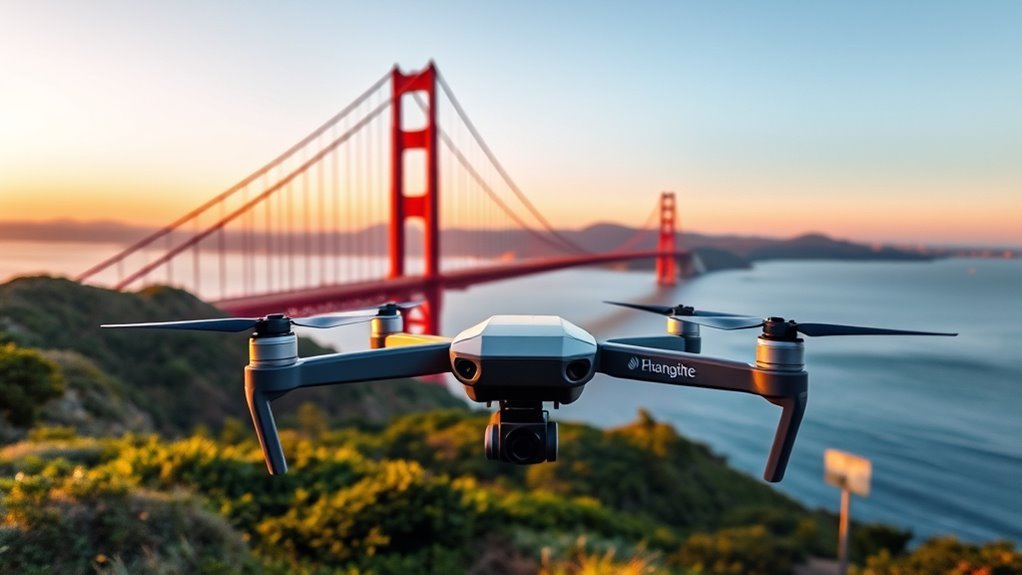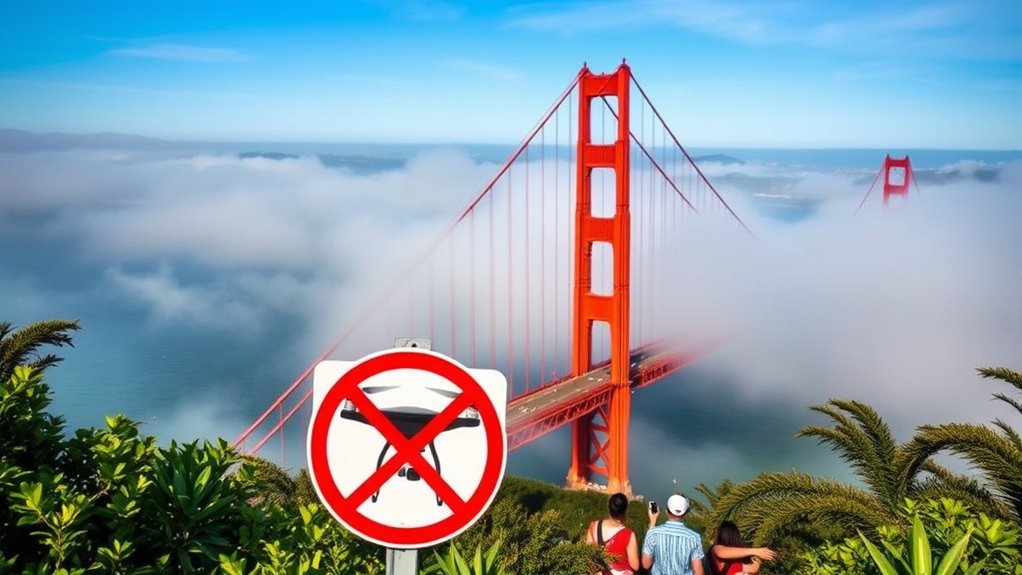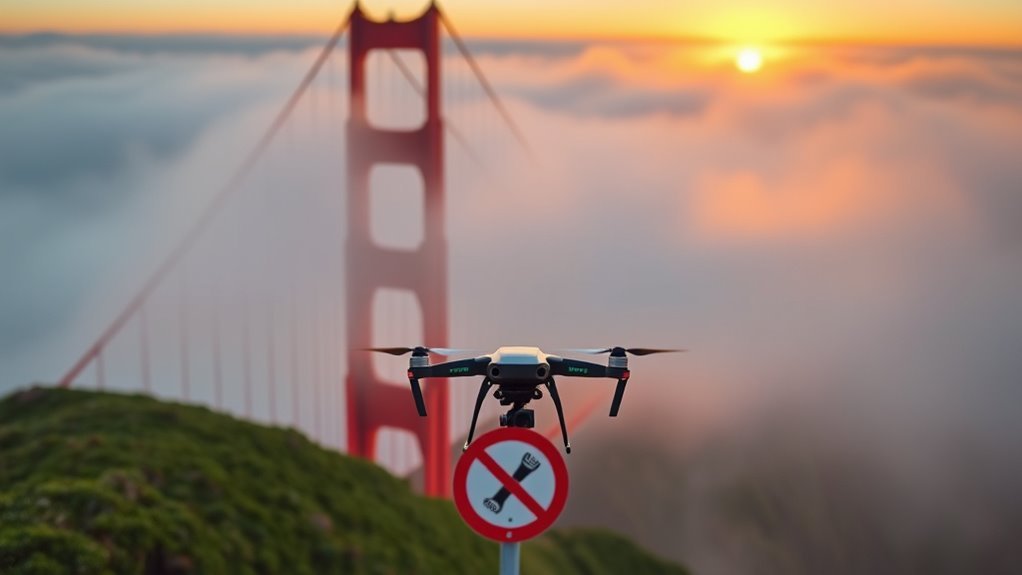To fly drones near the Golden Gate Bridge, you must comply with National Park Service regulations, FAA guidelines, and local ordinances. Drone use is largely banned in national parks and restricted airspace, including over the bridge itself. You need to maintain a visual line-of-sight, register drones over 0.55 pounds, and avoid designated security zones. Violating these rules can result in fines or legal action. Discover further details on permits, safety tips, and operational best practices.
Understanding the National Park Service Regulations

Although flying drones can be an exhilarating experience, it’s vital to understand the regulations set forth by the National Park Service (NPS) when it comes to the Golden Gate Bridge area. The NPS prohibits drone use in most park areas to guarantee drone safety and protect wildlife. You’ll need to plan your visit carefully, as park access is restricted for drone enthusiasts. Always check the latest NPS guidelines before heading out, as these regulations can change. Knowing where you can and can’t fly is important for enjoying your experience without legal repercussions. Remember, respecting these rules not only enhances your freedom to explore but also preserves the natural beauty of this iconic landmark for everyone to enjoy.
FAA Guidelines for Drone Operation

When flying drones near the Golden Gate Bridge, you must adhere to FAA guidelines that include specific airspace restrictions and pilot certification requirements. Understanding these regulations is essential for ensuring safety and compliance. Ignoring them can lead to serious consequences, so it’s important to be informed and prepared.
Airspace Restrictions
Flying drones near the Golden Gate Bridge requires strict adherence to airspace restrictions set by the FAA. These guidelines are essential for maintaining safety and facilitating effective airspace management. You’ll find that the area around the bridge falls within controlled airspace, which means you’ll need to avoid unauthorized flights. Familiarize yourself with drone technology to navigate these regulations smoothly. Always check for temporary flight restrictions, especially during special events or emergencies. By respecting these airspace rules, you’re not only protecting yourself but also ensuring that everyone can enjoy the beauty of the bridge without disruption. Remember, freedom in flying comes with responsibility—stay informed and fly smart.
Pilot Certification Requirements
To operate a drone legally near the Golden Gate Bridge, you must meet specific pilot certification requirements set forth by the FAA. First, you’ll need to obtain a Remote Pilot Certificate, which involves passing the FAA’s Aeronautical Knowledge Test. This process assesses your understanding of airspace regulations, weather, and drone operation, guaranteeing you possess the necessary pilot skills to fly safely. Additionally, you should register your drone and adhere to operational guidelines. Staying updated on regulations is vital, as rules can change. By completing the certification process and following these guidelines, you’ll not only enjoy the freedom to fly your drone but also secure the safety of yourself and others in this iconic area.
Restricted Airspace Around the Golden Gate Bridge

When flying drones near the Golden Gate Bridge, it’s essential to understand the restricted airspace regulations set by the FAA. These guidelines not only dictate safe operational altitudes but also include local ordinances that may impose additional restrictions. Ignoring these regulations can lead to serious legal consequences and safety hazards.
FAA Regulations Overview
Although drone enthusiasts may be enthusiastic to capture stunning aerial views of the Golden Gate Bridge, they must navigate a complex web of FAA regulations due to the area’s designation as restricted airspace. The FAA has established specific guidelines to guarantee safety and security, particularly around iconic landmarks. You’ll need to check the NOTAMs (Notices to Airmen) for temporary flight restrictions and confirm your drone technology complies with federal rules. Flying within a five-mile radius requires you to notify nearby airports, and you must maintain visual line-of-sight with your drone. If you want to pursue aerial photography in this breathtaking location, understanding and adhering to these regulations is vital to avoid penalties and guarantee a smooth flying experience.
Local Ordinances Impact
While the FAA regulations provide a federal framework for drone operations, local ordinances also play an essential role in shaping where and how you can fly near the Golden Gate Bridge. You’ll need to stay informed about specific local regulations that impose additional drone restrictions beyond federal guidelines. For instance, flying in certain parks or public spaces may be prohibited, and you might face fines for non-compliance. Additionally, local authorities may designate no-fly zones that affect your ability to capture stunning aerial views. Always check the latest updates from local governments or park services to verify you’re flying legally and safely. Remember, respecting these laws not only preserves your freedom but also the integrity of the beautiful surroundings.
Local Ordinances Affecting Drone Flight
Local ordinances play an essential role in regulating drone flight around the Golden Gate Bridge, as they help guarantee safety and preserve the area’s iconic landscape. You need to be aware of specific local laws that may impose restrictions on drone usage, particularly in designated flight zones. In many cases, drone registration is mandatory before you can operate your UAV in these areas. Local regulations may also limit where you can fly, especially near sensitive sites like parks or historical landmarks. Ignoring these ordinances could result in hefty fines or even legal action. Always check local guidelines to verify you’re in compliance and fully enjoying your freedom to fly while respecting the community and environment around you.
Safety Considerations While Flying Drones
When flying drones near the Golden Gate Bridge, safety should always be your top priority. Understanding drone safety is essential to guarantee a smooth and enjoyable experience. Before you launch, familiarize yourself with the operational limits of your drone and the surrounding environment. Always maintain visual line of sight with your drone to avoid unexpected obstacles and guarantee safe navigation. You should also have emergency procedures in place; know how to quickly regain control or land safely if something goes wrong. Keep an eye on weather conditions, as they can change rapidly, impacting your flight. By prioritizing these safety considerations, you can enjoy the freedom of flying your drone while minimizing risks to yourself and others. It is also crucial to understand local regulations to ensure compliance with the rules governing drone flights in the area.
No-Fly Zones in the Vicinity
When flying drones near the Golden Gate Bridge, you must be aware of several no-fly zones that are enforced for safety and security. The Federal Aviation Administration has specific regulations, while local parks have their own restrictions, and security zones further limit where you can operate. Ignoring these rules can lead to serious penalties, so it’s essential to understand and respect these boundaries.
Federal Aviation Administration Regulations
The Federal Aviation Administration (FAA) enforces strict regulations regarding drone operations near the Golden Gate Bridge, designating this area as a no-fly zone to secure public safety and security. If you’re planning to fly your drone nearby, you need to know that violating these regulations can lead to severe penalties. It’s essential to stay informed about the latest rules and make sure you have appropriate drone insurance in case of accidents. Additionally, familiarize yourself with emergency procedures to handle any unexpected incidents during your flight. By adhering to these regulations and preparing for emergencies, you can enjoy the freedom of flying your drone while respecting the safety of others and the integrity of this iconic location.
Local Park Restrictions
Although you might be enthusiastic to capture stunning aerial views, it is important to be aware that several local parks near the Golden Gate Bridge impose specific no-fly restrictions. These local park regulations create designated drone flight zones, ensuring both safety and preservation of natural spaces. Parks such as Golden Gate National Park and Presidio restrict drone usage to protect wildlife and maintain the serenity of the environment. Before you fly, check the specific guidelines for each park, as violating these rules can lead to fines or confiscation of your equipment. Being informed not only enhances your flying experience but also respects the delicate ecosystems that surround this iconic landmark. Stay compliant to enjoy your freedom while flying responsibly.
Security Zone Limitations
Drones are strictly prohibited in several designated security zones around the Golden Gate Bridge, which includes airspace restrictions enforced by federal regulations. These limitations are essential for ensuring public safety and preserving the integrity of critical infrastructure. Familiarizing yourself with these no-fly zones is important if you want to utilize drone technology responsibly.
| Security Zone | Restrictions |
|---|---|
| Golden Gate Bridge | No drone operations allowed |
| Presidio Military Base | Airspace is off-limits |
| Marin Headlands | Restricted airspace |
| Alcatraz Island | No drone access permitted |
Understanding these security zone limitations will help you navigate your drone flying pursuits while respecting the necessary regulations in place.
Tips for Capturing Great Aerial Footage
How can you guarantee your aerial footage of the Golden Gate Bridge stands out? First, master essential aerial techniques. Fly at various altitudes to capture unique perspectives; low angles can reveal details while higher shots showcase the bridge’s grandeur. Experiment with different flight paths to add dynamism to your shots.
Next, pay attention to your camera settings. Use a higher shutter speed to avoid motion blur, especially in windy conditions, and adjust your ISO for ideal lighting. Consider using ND filters to control exposure without sacrificing image quality. Additionally, ensure you select a drone with a 1-inch CMOS sensor for optimal image clarity and detail, as this sensor type is crucial for achieving sharp, vibrant images in varying light conditions.
Finally, shoot during golden hours—early morning or late afternoon—for breathtaking natural light. With these tips, you’ll capture stunning footage that truly embodies the beauty of this iconic landmark.
Obtaining Necessary Permits and Licenses
Before you take to the skies near the Golden Gate Bridge, you’ll need to navigate the regulatory landscape to guarantee compliance. Understanding the drone registration requirements and the licensing process is essential for responsible flying. Here’s what you need to know:
- Register your drone with the FAA if it weighs over 0.55 pounds.
- Obtain a Remote Pilot Certificate to operate commercially.
- Familiarize yourself with local regulations governing drone use in national parks.
- Check for any special permits required for flying in sensitive areas.
Respecting Privacy and Property Rights
When flying near the Golden Gate Bridge, have you considered the impact of your drone on the privacy and property rights of those nearby? Respecting these rights isn’t just good drone etiquette; it’s essential for maintaining a harmonious relationship with the community. Remember, many individuals may feel uneasy about drones invading their personal space, raising legitimate privacy concerns. Always be mindful of where you’re flying and avoid capturing images or videos of private property without permission. This not only prevents potential conflicts but also showcases your commitment to responsible drone usage. By prioritizing the privacy of others, you not only enhance your freedom to fly but also contribute to a positive environment for all drone enthusiasts.
Consequences of Violating Drone Regulations
Failing to adhere to drone regulations near the Golden Gate Bridge can lead to serious consequences, both legally and financially. You should be aware that violations can result in:
- Legal penalties such as hefty fines or even criminal charges.
- Drone confiscation by authorities, leaving you without your equipment.
- Civil lawsuits if you infringe on someone’s privacy or property rights.
- Permanent bans from flying drones in designated areas.
These repercussions can stifle your freedom to explore and capture breathtaking views. By understanding and respecting the regulations, you can enjoy your drone experience without the looming threat of legal trouble. Prioritize compliance, and you’ll guarantee that your passion for flying remains unimpeded.
Frequently Asked Questions
Can I Fly My Drone at Night Near the Golden Gate Bridge?
You can’t fly your drone at night near the Golden Gate Bridge without proper authorization. Night flying comes with specific drone regulations that you must follow to guarantee safety and compliance. Always check local guidelines.
What Happens if My Drone Crashes Near the Bridge?
If your drone crashes near the bridge, it’s like a fallen leaf in a storm; recovery efforts become essential. Prioritize bridge safety, as disruptions can lead to fines or damage claims. Stay cautious and informed.
Are There Specific Times When Drone Flying Is Prohibited?
Yes, there’re specific times when drone flying is prohibited. You should be aware of drone regulations and flying restrictions, especially during events or emergencies, to guarantee safety and compliance while enjoying your freedom in the skies.
How Can I Report a Drone Violation in the Area?
If you witness a drone violation, you can report it to local authorities or the FAA. Follow established reporting procedures for drone regulation enforcement to guarantee your concerns are addressed while promoting safe flying practices.
Is Insurance Required for Flying Drones Near the Golden Gate Bridge?
Flying a drone’s like dancing with the wind; you’ve got to know the steps. While insurance coverage isn’t always required, understanding drone regulations is essential to protect yourself and avoid potential liabilities in any flight.

